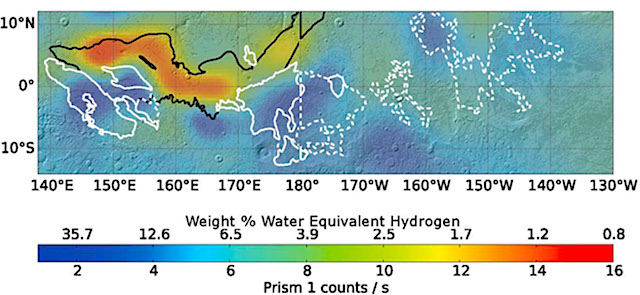 Scientists taking a new look at older data from NASA’s longest-operating Mars orbiter have discovered evidence of significant hydration near the Martian equator — a mysterious signature in a region of the Red Planet where planetary scientists figure ice shouldn’t exist.
Scientists taking a new look at older data from NASA’s longest-operating Mars orbiter have discovered evidence of significant hydration near the Martian equator — a mysterious signature in a region of the Red Planet where planetary scientists figure ice shouldn’t exist.
Jack Wilson, a post-doctoral researcher at the Johns Hopkins University Applied Physics Laboratory in Laurel, Maryland, led a team that reprocessed data collected from 2002 to 2009 by the neutron spectrometer instrument on NASA’s Mars Odyssey spacecraft. In bringing the lower-resolution compositional data into sharper focus, the scientists spotted unexpectedly high amounts of hydrogen — which at high latitudes is a sign of buried water ice — around sections of the Martian equator.
[The paper is published in Icarus.]
An accessible supply of water ice near the equator would be of interest in planning astronaut exploration of Mars. The amount of delivered mass needed for human exploration could be greatly reduced by using Martian natural resources for a water supply and as raw material for producing hydrogen fuel.
By applying image-reconstruction techniques often used to reduce blurring and remove “noise” from medical or spacecraft imaging data, Wilson’s team improved the spatial resolution of the data from around 320 miles to 180 miles (520 kilometers to 290 kilometers). “It was as if we’d cut the spacecraft’s orbital altitude in half,” Wilson said, “and it gave us a much better view of what’s happening on the surface.” [More at links]








